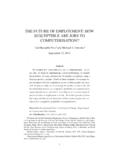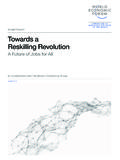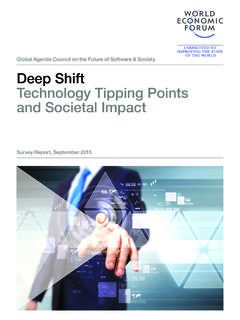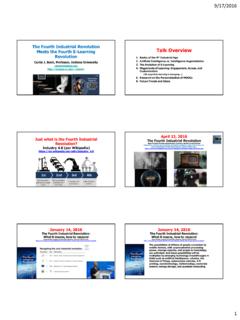Transcription of AI: Bringing smarter automation to the factory floor
1 AI: Bringing smarter automation TO THE factory Document 2017 Infosys LimitedAI: Bringing smarter automation TO THE factory FLOORSOURCE: AMPLIFYING HUMAN POTENTIAL - TOWARDS PURPOSEFUL ARTIFICIAL INTELLIGENCE 3 The economics of investing in robotic efficiencies is not lost on manufacturers. With robots attaining greater degrees of sensitivity in their touch capabilities, they will be able to take over many assembly and movement-dependent activities on the future manufacturing floor . At the same time, improvement in sensor and vision technology is creating smarter , lighter and friendlier co-bots that humans can work with safely. Savvy manufacturers will buck the offshore trend, use data to replace inventory, and experience enormous improvements in efficiency and reduction in costs as robots take over most of the assembling, moving, packaging, transporting and other physical tasks.
2 Robots will be collaborative, working together and giving each other feedback. They will learn and improve and make smarter decisions not just deterministic ones based on their programming, but proactive ones based on their experiences. With advancing adoption of AI, manufacturers can leave the mundane and routine tasks to automation and free themselves up to pursue new ideas and new ways of thinking and making that s beyond the realm of machines. An Infosys viewpoint 4 External Document 2017 Infosys LimitedAI: Bringing smarter automation TO THE factory FLOORSOURCE: AMPLIFYING HUMAN POTENTIAL - TOWARDS PURPOSEFUL ARTIFICIAL INTELLIGENCE The manufacturing sector is evolving into a new state, fueled by massive digital business transformation efforts.
3 Artificial Intelligence (AI) is being used to support and even change the role of the human workforce in the physical workplace. The most dramatic impact of the technology is in Bringing efficiency and simplicity to manufacturing s many complex processes and machine-to-machine interactions spanning products and assets, within factories and across global supply networks. From conventional production line robotic equipment consisting of one-bot-per-task systems, automation has now evolved to power and manage multiple tasks simultaneously. AI is the driving force behind a new era of mechanization where processes are being modernized to make production decisions smarter and real part of its study Amplifying Human Potential: Towards Purposeful Artificial Intelligence, Infosys commissioned independent research to investigate the approach and attitudes that senior decision-makers in large organizations have towards AI technology and how they see the future application and development of AI in their industries.
4 As part of the research, 10 industries were surveyed Retail, Fast Moving Consumer Goods (FMCG), Utilities, Financial Services, Healthcare, Pharmaceuticals and Life Sciences, Manufacturing, Telecoms, Automotive and Aerospace, and the Public follows is a glimpse into the findings specific to the manufacturing Document 2017 Infosys LimitedAI: Bringing smarter automation TO THE factory FLOORSOURCE: AMPLIFYING HUMAN POTENTIAL - TOWARDS PURPOSEFUL ARTIFICIAL INTELLIGENCE 5 Having been an aggressive user of robotics and mechanization for decades, AI is the next logical step for the manufacturing sector to improve productivity, production line and tooling utilization as well as to minimize production cost per unit.
5 To achieve this, manufacturers have been using AI systems as part of their operations for an average of two years, with more than half (58 percent) using AI technology for between one and three years, with a further 17 percent actively using AI for between three and five years. Overall, 29 percent of manufacturers surveyed have fully deployed some form of AI or automation SMART MANUFACTURERS ARE AUTOMATING DATA AND PROCESSES technology as part of their operations and decision-making processes not just for data analytics, but to automate decision-making and guidance for human decision-makers. For example, when a car maker is running low on a particular component, software can automatically order production of new units.
6 If an entirely new part is needed, the order is dispatched to design teams. Using automated 3D printing technologies, the manufacturer can design, prototype and test a new part in hours instead of days or weeks. For how long has your organization been using AI technology?Fewer than six months1%3-5 years17%22%Six months to a year2%More than five years58%1-3 years2 Average number of years the respondents organizations have been using AI technology6 External Document 2017 Infosys LimitedAI: Bringing smarter automation TO THE factory FLOORSOURCE: AMPLIFYING HUMAN POTENTIAL - TOWARDS PURPOSEFUL ARTIFICIAL INTELLIGENCE With each stage being monitored by sensors that feed data to AI-driven analytics software, a manufacturer can determine the production processes of each product much faster than with manual processes alone.
7 Over half (57 percent) of manufacturers are primarily focusing on investing into security systems and 44 percent into data analytics, for this reason. IT (71 percent) and the operations (31 percent) departments are the most active in their use of AI, while HR (6 percent) and senior management (9 percent) are the least likely to use AI technology. As per the study, the security department is the top active user of AI for its day-to-day processes; this is valuable insight into the direction AI will head in for the manufacturing sector. External Document 2017 Infosys LimitedAI: Bringing smarter automation TO THE factory FLOORSOURCE: AMPLIFYING HUMAN POTENTIAL - TOWARDS PURPOSEFUL ARTIFICIAL INTELLIGENCE 7 With robots attaining greater degrees of sensitivity in their touch capabilities, savvy manufacturers are embracing robotics in greater volume to increase efficiency and work rates on production, picking and packing lines.
8 AI and robotics will be able to take over many assembly and movement-dependent activities on the evolving manufacturing floor , and HOW AI WILL IMPACT FUTURE OF MANUFACTURING reduce costs. At the same time, it will improve sensor and vision technology to create smarter , lighter and friendlier co-bots that humans can work with safely. For example, automobile maker BMW s self-driving Smart Transport Robot travels the floor and sends out communication on any critical situation it your opinion, which areas of AI do you feel require the most improvement before it can be most effective for your organization?Cost reduction48%Time to implement44%Proof of concept/ROI44%Transparency ( being able to demonstrate how the technology/algorithm works)44%Ease of use40%Interoperability with other systems and platforms35%Training37%Enterprise-grade support18%There are no areas for improvement5%8 External Document 2017 Infosys LimitedAI: Bringing smarter automation TO THE factory FLOORSOURCE.
9 AMPLIFYING HUMAN POTENTIAL - TOWARDS PURPOSEFUL ARTIFICIAL INTELLIGENCE Alongside these improvements in experience, efficiency, produce-cost reduction and service, AI in manufacturing will deliver opportunities for more personalized and customized manufacturing which will impact the retail space. For example, a retail chain could locate their own manufacturing robot or 3D printer in each store to produce apparel on demand with customized fit, colors, material, and cut based on customer preferences. In addition to automating the process, this also relocates the manufacturing process to a more distributed but still centrally controllable model that shortens the distance between raw materials and end half of all manufacturers (56 percent) will prioritize developing new products and services when using AI technology over the next three years, and with one of the top benefits of AI in manufacturing being efficiency in experience and produce, this is a positive step forward for the sector.
10 The automation of manufacturing will also support the notion of mass customization and on-demand production of , AI will bring challenges as well. 37 percent of manufacturers believe that training will be a significant issue when it comes to deploying AI. They will have to ensure training is thoroughly implemented across departments, guaranteeing manufacturers understand what AI is, and how it can benefit and bring about industry progression. Some 32 percent of manufacturers admit to a lack of knowledge about where AI can assist in the industry. The rapid evolution and convergence of multiple disruptive technologies that are part of AI make this a continuous challenge.














